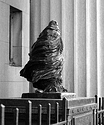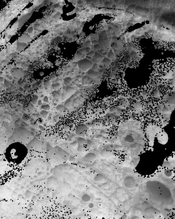Isaacm9
Member
First post here! I have been coating and shooting dry plates using Liquid Light emulsion for a while now, but this newest batch, all from one bottle, is doing something strange. The emulsion comes off in flakes all across the plate. They all exhibit this to varying degrees, despite appearing completely normal before processing. I'm thinking I likely messed up somewhere along the way, but I'm wondering if someone has had a similar experience. Using a traditional chrome alum hardened gelatin subbing and Rockland Liquid Light heated to around 140 during coating. Plates cleaned with calcium carbonate.
I've taken all these steps with different batches and had no issues with flaking. The only common denominator is the bottle of emulsion and the subbing batch. Let me know if you have any ideas on what this could be, and thanks! Included images are one detail from a scan and a picture of the negative/
I've taken all these steps with different batches and had no issues with flaking. The only common denominator is the bottle of emulsion and the subbing batch. Let me know if you have any ideas on what this could be, and thanks! Included images are one detail from a scan and a picture of the negative/







